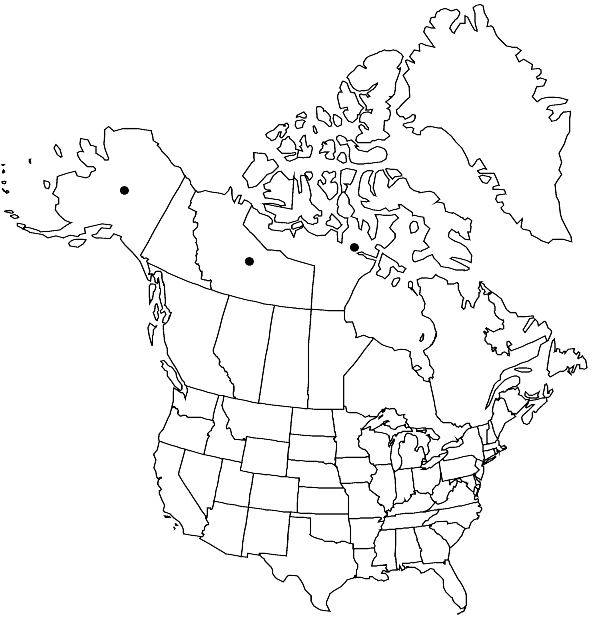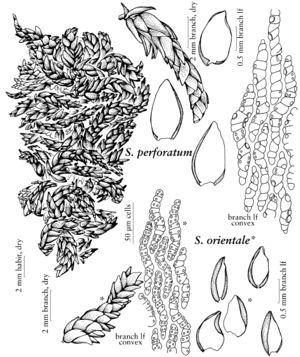Difference between revisions of "Sphagnum orientale"
Bot. Mater. Otd. Sporov. Rast. Bot. Inst. Komarova Akad. Nauk S.S.S.R. 7: 206. 1951,.
FNA>Volume Importer |
FNA>Volume Importer |
||
| Line 21: | Line 21: | ||
|elevation=low to moderate elevations | |elevation=low to moderate elevations | ||
|distribution=Nunavut;N.W.T.;Alaska;Asia. | |distribution=Nunavut;N.W.T.;Alaska;Asia. | ||
| − | |discussion=<p>The ecology of Sphagnum orientale is poorly known, due in part to taxonomic confusion with S. perfoliatum and in part to its very northern distribution. Like other species of sect. Subsecunda, however, it is clearly minerotrophic, probably weakly so. Associated vascular plants include Carex aquatilis Wahlenberg, C. bigelowii Torrey, C. fuliginosa Schkuhr, C. rotundata Wahlenberg, Eriophorum vaginatum Linnaeus, Vaccinium oxycoccus Linnaeus, and Betula glandulosa Michaux. Associated bryophytes include Sphagnum aongstroemii, S. fimbriatum subsp. concinnum, S. jensenii, S. obtusum, S. rubellum, S. talbotianum, S. squarrosum, and Cinclidium subrotundatum. Sporophytes are rare. Similar species with which it overlaps in range are S. subsecundum, S. perfoliatum and S. inexspectatum. Field separation from S. subsecundum and S. inexspectatum is difficult but the tiny branch leaf pores will separate it microsopically. Sphagnum perfoliatum is much larger and indeed looks much like some forms of S. lescurii or S.auriculatum, even to having curved, horn-like branches. Sphagnum perfoliatum is also typically quite richly colored and glossy in appearance.</p> | + | |discussion=<p>The ecology of <i>Sphagnum orientale</i> is poorly known, due in part to taxonomic confusion with <i>S. perfoliatum</i> and in part to its very northern distribution. Like other species of sect. Subsecunda, however, it is clearly minerotrophic, probably weakly so. Associated vascular plants include <i>Carex aquatilis</i> Wahlenberg, <i>C. bigelowii</i> Torrey, <i>C. fuliginosa</i> Schkuhr, <i>C. rotundata</i> Wahlenberg, <i>Eriophorum vaginatum</i> Linnaeus, <i>Vaccinium</i> oxycoccus Linnaeus, and <i>Betula glandulosa</i> Michaux. Associated bryophytes include <i>Sphagnum aongstroemii</i>, <i>S. fimbriatum </i>subsp.<i> concinnum</i>, <i>S. jensenii</i>, <i>S. obtusum</i>, <i>S. rubellum</i>, <i>S. talbotianum</i>, <i>S. squarrosum</i>, and <i>Cinclidium</i> subrotundatum. Sporophytes are rare. Similar species with which it overlaps in range are <i>S. subsecundum</i>, <i>S. perfoliatum</i> and <i>S. inexspectatum</i>. Field separation from <i>S. subsecundum</i> and <i>S. inexspectatum</i> is difficult but the tiny branch leaf pores will separate it microsopically. <i>Sphagnum perfoliatum</i> is much larger and indeed looks much like some forms of <i>S. lescurii</i> or S.auriculatum, even to having curved, horn-like branches. <i>Sphagnum perfoliatum</i> is also typically quite richly colored and glossy in appearance.</p> |
|tables= | |tables= | ||
|references= | |references= | ||
| Line 44: | Line 44: | ||
|publication year= | |publication year= | ||
|special status= | |special status= | ||
| − | |source xml=https://jpend@bitbucket.org/aafc-mbb/fna-data-curation.git/src/ | + | |source xml=https://jpend@bitbucket.org/aafc-mbb/fna-data-curation.git/src/8f726806613d60c220dc4493de13607dd3150896/coarse_grained_fna_xml/V27/V27_74.xml |
|genus=Sphagnum | |genus=Sphagnum | ||
|section=Sphagnum sect. Subsecunda | |section=Sphagnum sect. Subsecunda | ||
Revision as of 16:57, 18 September 2019
Plants pale yellow-brown, grey-green, to dark brown. Stems green to brownish; superficial cortex of 1 and often irregularly 2 layers of inflated, thin-walled cells. Stem leaves triangular-lingulate to lingulate; 0.7–0.8 mm; apex rounded and often erose, hyaline cells nonseptate or sometimes 1-septate, numerous small round pores more than 2 µm along the commissures and scattered across the cell on the convex surface, on the concave surface fewer similar-sized pores along the commissures. Branches short and slightly curved Branch fascicles with 2 spreading and 2 pendent branches. Branch leaves ovate, 1.1–1.3 mm, distinctly curved to secund; hyaline cells covered with numerous (more than 30 per cell) tiny pores (ca. 1 µm) on convex surface along the commissures and across the cell surface, sometimes forming several linear rows of free pores, on concave surface with fewer pores round to oval and slightly larger (more than 2 µm) restricted to commissures. Sexual condition probably dioicous. Capsule not seen. Spores not seen.
Habitat: Commonly in muskeg pond margins, low center polygons, wet meadows, and tundra pool margins, usually occurring in very wet or submerged habitats
Elevation: low to moderate elevations
Distribution

Nunavut, N.W.T., Alaska, Asia.
Discussion
The ecology of Sphagnum orientale is poorly known, due in part to taxonomic confusion with S. perfoliatum and in part to its very northern distribution. Like other species of sect. Subsecunda, however, it is clearly minerotrophic, probably weakly so. Associated vascular plants include Carex aquatilis Wahlenberg, C. bigelowii Torrey, C. fuliginosa Schkuhr, C. rotundata Wahlenberg, Eriophorum vaginatum Linnaeus, Vaccinium oxycoccus Linnaeus, and Betula glandulosa Michaux. Associated bryophytes include Sphagnum aongstroemii, S. fimbriatum subsp. concinnum, S. jensenii, S. obtusum, S. rubellum, S. talbotianum, S. squarrosum, and Cinclidium subrotundatum. Sporophytes are rare. Similar species with which it overlaps in range are S. subsecundum, S. perfoliatum and S. inexspectatum. Field separation from S. subsecundum and S. inexspectatum is difficult but the tiny branch leaf pores will separate it microsopically. Sphagnum perfoliatum is much larger and indeed looks much like some forms of S. lescurii or S.auriculatum, even to having curved, horn-like branches. Sphagnum perfoliatum is also typically quite richly colored and glossy in appearance.
Selected References
None.
